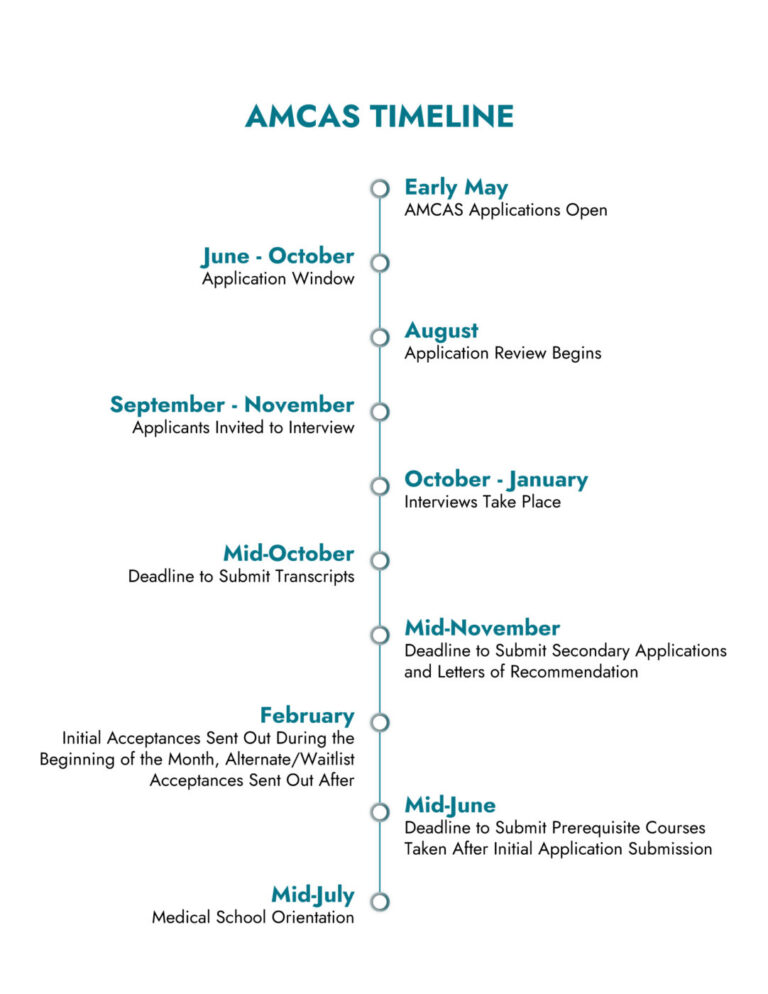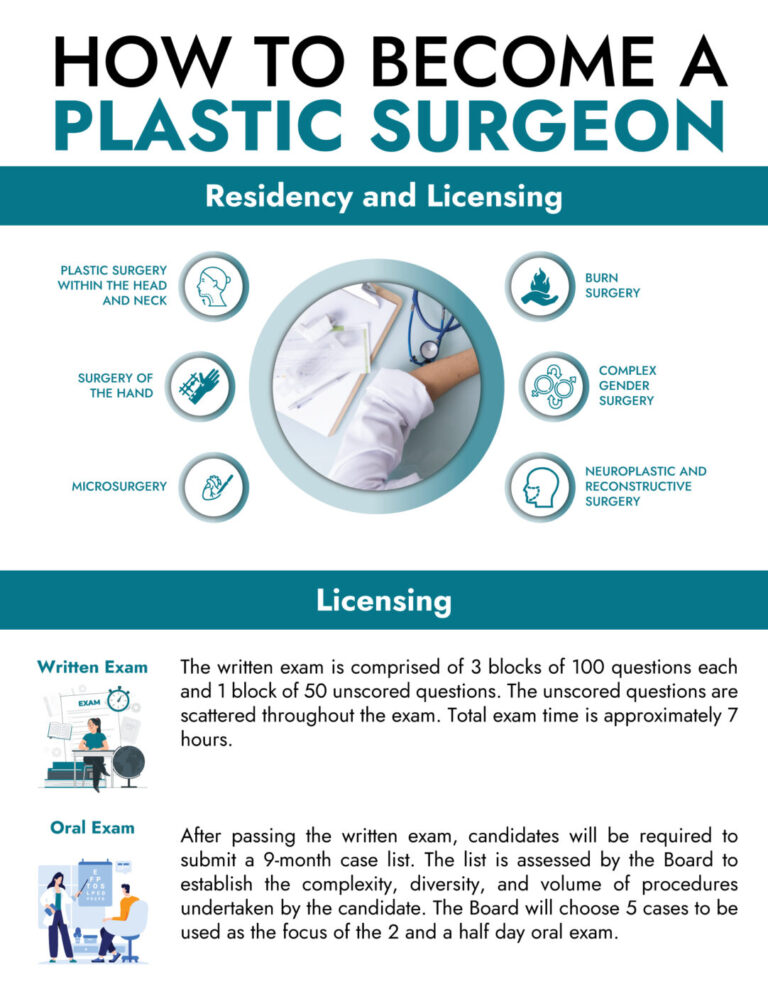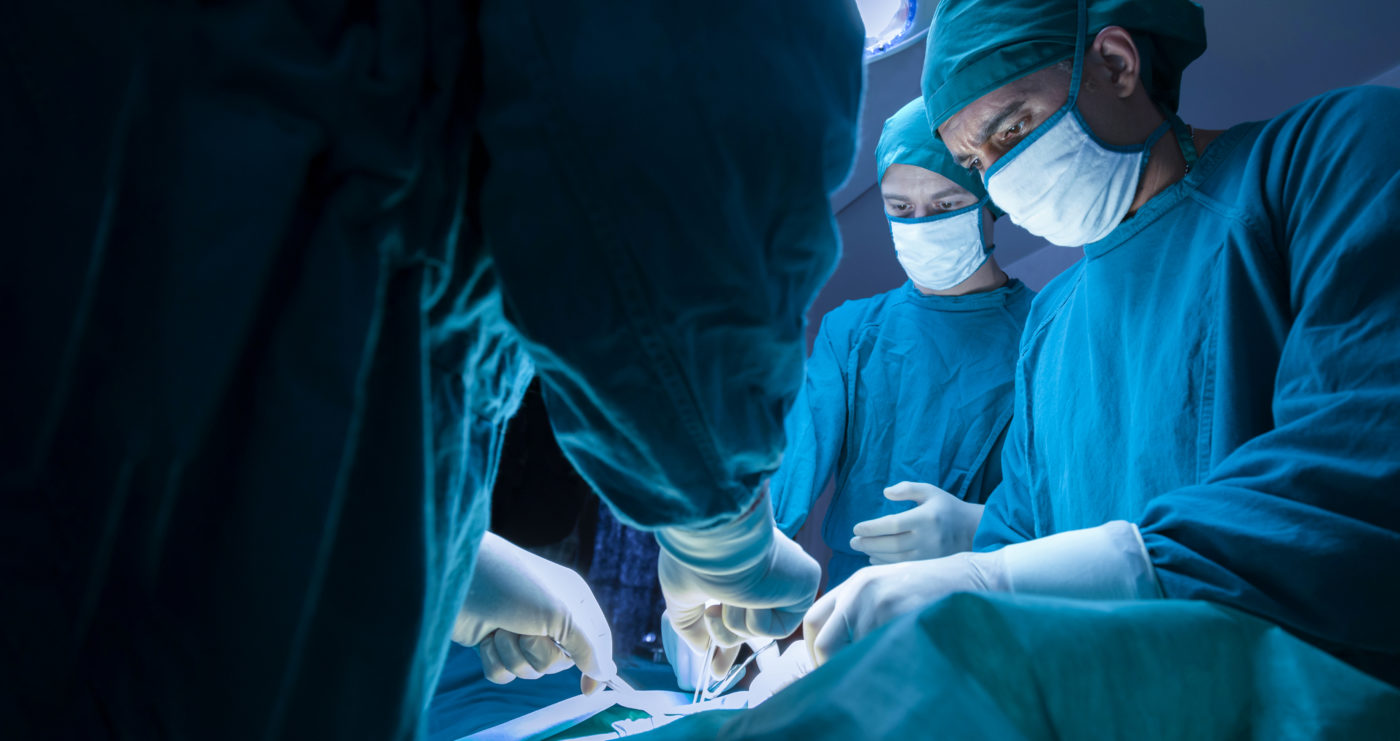Have you been wondering how to become a plastic surgeon, or maybe you are just considering a career in plastic surgery? Those who feel drawn to a career in medicine and have an artistic side may do well as plastic surgeons. A plastic surgeon is a medical doctor who performs reconstructive surgeries to repair or reconstruct parts of the patient’s body. This article sheds light on how to become a plastic surgeon from the career, training, certifications, and plastic surgeon salary.
Plastic surgeons are specialists. They perform both cosmetic and non-cosmetic procedures as part of their medical practice. This career requires a keen eye and a strong sense of aesthetics. In addition to being one of the most competitive residencies, this career medical specialty frequently ranks among the highest-paid doctors in the world.
Skills a Plastic Surgeon Should Possess
Empathy
Plastic surgeons are responsible for performing life-changing surgeries. Patients want to know that their concerns, fears, and worries are addressed and heard by their doctor. No patient wants to walk into the procedure room and feel that their doctor doesn’t care about them or the results of the procedure. The practitioner should be a good listener and understand the patient’s motivations behind receiving the procedure.
Communication Skills
All physicians should possess good communication skills, but these skills are especially important for plastic surgeons. Plastic surgeons assist patients with the repair and reconstruction of many parts of the body. When aiding someone through such a life-changing procedure, it is crucial to have great communication skills. You need to be able to articulate the goals and potential outcomes of the procedure fully.
Excellent With Their Hands
While this is another skill all doctors should display, this skill is crucial in the field of cosmetic surgery. Oftentimes, plastic surgeons are tasked with repairing and reconstructing a patient’s face or other sensitive areas. Facial surgery is a delicate procedure, and any small error can result in a drastic change in the final results.
Requirements and Training Process
In the United States, the path to becoming a fully licensed plastic surgeon is a long one. The first step those wondering how to become a plastic surgeon will take is premed school. You’ll need to begin with an undergraduate degree like a BA or BSc. Aspiring plastic surgeons will also need to begin proper medical training in a 4-year medical school accredited by the AAMC, followed by a 6-year residency in Plastic Surgery accredited by the ACGME. During this process, you will take exams both for licensing and qualifying. These exams include the MCAT before going to medical school and the USMLE during your time in med school and your residency. You will need to take the board certification exams at the end of your residency.
Becoming a plastic surgeon is a huge investment of both time and energy, with the entire process taking around 14 years from the start of your undergrad to becoming a physician. The process could take even longer if you decide to take subspecialty training after your residency. However, a career as a plastic surgeon can be highly rewarding and well worth the 14-plus years of schooling, training, and certification.
Undergraduate Degree and Prerequisites
The first step in the journey to becoming a board-certified plastic surgeon is completing an undergraduate degree. This can be a Bachelor of Arts (BA) or a Bachelor of Science (BS or BSc). This phase of the training process is commonly referred to as premed.
A common misconception regarding the premed step of the process is that students who choose to receive a degree/major in an area seemingly more science related, such as biology, have a leg up when it comes to getting accepted to medical school. However, according to surveys, students who graduate with a degree in the fields of mathematics, humanities, and social sciences fair equally well in terms of being accepted into medical school.
The medical field requires many unique skill sets, from communication skills to in-depth knowledge of chemistry and dexterity to psychology knowledge. Don’t view your undergraduate in terms of what major to choose. Instead, think in terms of what courses you need for medical school and how you can graduate with a high GPA. As with most things, you need to find the balance between studying relevant topics and boosting your “numbers.”
Most medical schools list the required courses and prerequisites for admission to their medical program. When crafting your undergrad plan, your first step is to create a list of the medical schools you would like to attend and their prerequisites. The Medical School Admission Requirements Database (MSAR) from the AAMC is a great resource for this information. For further assistance putting together your undergrad plan, consider personalized help from IMA Admissions Consulting regarding how to become a plastic surgeon.
Most medical school prerequisite lists include the following:

The majority of medical schools will accept these prerequisites if taken at a community college or international school. However, medical schools do not commonly accept credits for these prerequisites acquired through College Level Examination Programs (CLEPs). Overall, medical schools value more traditional learning environments, such as full-length in-person classes from accredited universities.
Taking the MCAT
As most students approach the midway point in their undergrad years, they will need to begin preparing for the MCAT, also known as the Medical College Admissions Test. Not all medical schools require the MCAT, but the majority of medical schools do, so this should be a mandatory step in your journey to becoming a plastic surgeon.
First, you will need to ensure that you have a grasp on your medical school application timeline. The majority of med schools in the US have similar calendars for how and when to submit your application materials through AMCAS. Although many medical schools have similar application timelines, it is important to know the timeline for each school you intend to apply to, and a crucial piece of info needed for your application is the MCAT.
Unless you are a non-traditional applicant or following a non-standard timeline, you will want to begin planning your study schedule for the MCAT sometime after your second year of undergrad after completing all major prerequisites.
Your prep for the MCAT should start with taking the MCAT diagnostic test. The diagnostic test will assess your baseline strengths and weaknesses, helping you pinpoint areas in which you should improve and study harder. These results will aid in creating your MCAT study plan.
Applying to Medical School
Before actively beginning the process of applying to medical schools, you’ll need to review your desired school’s admissions data—make sure to check out the best medical schools for surgery. Checking the admissions data of your chosen medical school gives you a sense of how competitive the GPA and MCAT scores will be and what qualities the school values in its applicants.
Those looking for an additional edge when applying to medical school consider partaking in a pre-med shadowing study abroad program. The pre-med shadowing study abroad program offered through IMA helps give students experience in a clinical environment to add to their AMCAS application.
You will begin gathering your AMCAS materials during your third year in undergrad and aim to submit the materials and your application before the start of your fourth year. A standard AMCAS timeline will look like this:

The main elements in your AMCAS application should include the following:
Background Info and Primary Application
This section covers your identifying information, schools you’ve attended, and your basic biographical information, such as name, citizenship, date of birth, etc
Coursework and Transcripts
Although your transcript will be sent to AMCAS following your transcript request, you will also need to input the transcript’s contents into the coursework section of the application. This will cover basic information like dates of attendance, grades, overall GPA, and courses taken.
Letters of Recommendation
Letters of recommendation, sometimes referred to as letters of evaluation, are confidential letters written by a faculty member or a committee of writers to show support for your candidacy as a medical school applicant. Each medical school will have different requirements for these letters of recommendation. Some schools prefer a mix of individually written letters and letters written by a committee, while other schools prefer a single letter written by a committee of faculty members. Check your medical school’s requirements regarding letters of recommendation.
Work and Activities
The AMCAS Work and Activities section is similar to a CV. This section covers any relevant information not covered by your transcript. This includes research projects, clinical experience, extracurriculars, and volunteering. The AMCAS application includes room for 15 entries in this section, 3 of which you can identify as most meaningful.
Personal Statement
The personal statement portion of the AMCAS is your opportunity to share your story. While this section isn’t make or break like your MCAT score or GPA, this element allows you to speak directly to the applications committee and express your interest in the school, your future career path, and your personal story and motivations. The key to writing a personal statement is not to lapse into a marketing spiel about you and your skills. Keep your statement honest.
Secondary Applications and Essays
Most medical schools have a two-application system. This means they will assess your AMCAS application, and if the assessment is positive, they will send you a secondary application. The secondary application process includes essay prompts. These essay prompts give you the opportunity to express further your personal motivations and desires regarding your chosen career path. To best prepare for the secondary application and essays, consult secondary essay examples to get a feel for what type of questions medical schools ask. For further help will secondary application essays, consider enlisting the help of medical school admissions consulting.
During Medical School
Medical school is the second of the three educational phases you’ll take to become a plastic surgeon. Most medical school programs are a 4-year curriculum that shifts from coursework in class to clinical training and experiences.
During your first year in med school, you should expect to spend most, if not all of your time, in the classroom as the first year is very classroom-oriented. Your second year of medical school is still highly classroom-oriented but also mixes in some studies in specialties like internal medicine, pediatrics, emergency medicine, etc. The specialty studies vary from school to school, but overall, the school’s focus will be on developing your clinical knowledge and patient interaction skills through limited patient interactions in clinical environments. These specialty studies are sometimes referred to as “clerkships.” Clerkships are similar to a shadowing program, and some schools have core clerkships that must be completed to progress through the program. The phase of core clerkships will typically be completed midway through your third year of med school. After completing the core clerkships, you will begin electives and advanced clerkships on top of dedicating more of your time to research projects (depending on your program).
The primary load of coursework in medical school is science related. You should expect coursework in anatomy, biology, pharmacology, and microbiology. While there is plenty of science classes and coursework you will need to complete, these classes will be tied directly to how science can be used in the medical field. Most medical schools utilize the form of basic doctoring or another course related to developing an understanding of both clinical knowledge and practice, especially during the first year.
Throughout your time at medical school, you will need to take several United States Medical Licensing Exams, known as USMLEs. The USMLE is divided into 3 steps.
USMLE Step 1
The first step of the USMLE tests a student’s understanding of basic scientific methods and concepts related to the practice of medicine.
- 1-Day Exam (Often Divided Into Blocks)
- Administered Over the Course of 8 Hours
- 280 Question, Multiple-Choice Exam
USMLE Step 2
The second step of the USMLE focuses on testing the student’s medical knowledge and clinical skills pertaining specifically to patient care.
- 1-Day Exam (Often Divided Into 8 Blocks)
- 318 Multiple Choice Questions
- Typically taken during the first half of a student’s final year of medical school.
USMLE Step 3
The final step in the USMLE process tests a student’s medical and clinical knowledge within the context of unsupervised practice as a licensed physician.
- 2-Day Exam
- Day 1 Is Comprised of 232 Multiple Choice Questions (Often Split Into 6 Blocks)
- Day 2 Is Comprised of 30 Multiple Choice Questions and 13 Case Simulations (Often Broken Into 6 Blocks)
- Typically taken during the first year of a student’s residency program.
Residency Program Applications
Around the beginning of your third year of medical school, you’ll want to begin gathering the needed materials for residency program applications. A residency program application is submitted through the Electronic Residency Application Service (ERAS). The materials you submit through the ERAS are utilized by the NRMP (National Resident Matching Program). Overall, your ERAS application will be similar to the AMCAS application you submitted.
There are a couple of key differences between the two applications, though.
Curriculum Vitae
Your curriculum vitae (CV) in regard to your residency program application should include your training and experience in a neat, concentrated format. Your CV should showcase your academic achievements and extracurricular achievements. You should also briefly describe your clinical experience, any research projects you’ve participated in, and any publications you took part in.
Medical Student Performance Evaluation
A medical student performance evaluation (MSPE) is a form of transcript compiled by a committee of medical school faculty members. The MSPE includes your grades, clinical rotation assessments, class standing, and the overall medical school structure.
The “Noteworthy Characteristics” section of the MSPE allows both you and the committee writing the MSPE to list 3 characteristics that best describe you and your overall abilities. These characteristics can include your hobbies, work experience, research, and other non-academic roles. However, each of these 3 characteristics needs to be explained in under 40 words.
Specifically for plastic surgery residencies, you will want to discuss any surgery-related experiences and plastic surgery-specific experiences. You can discuss these experiences in your personal statement, but your MSPE should also reflect a strong performance in surgery. To display a strong record of surgery-related experiences, you will want to undertake surgery-related elective rotations, including general surgery and plastic surgery.
A medical school application doesn’t need to show a vast amount of specialty-related experience. A residency program application does. Your residency application should reflect your hard work and dedication toward your desired specialty and career path in medicine. These specific experiences can include shadowing as well, which is often easier to arrange than formal clerkships.
The standard ERAS timeline should have you submitting your materials in September of your fourth year of medical school. You should register yourself into the NRMP Match program the same month you submit your ERAS materials. Not too long after submitting these materials, usually, in October, you will begin interviewing with programs. While interviewing with these programs, you will rank the programs based on your preference. In March, students are matched to the residency programs that best fit them. From here, you’ll finish your final weeks of rotations and work, then set off for your residency.
Licensing and Residency
By this point in your journey to becoming a plastic surgeon, you are almost there! You may be wondering how long a plastic surgery residency program is. The standard plastic surgery residency program is around 6 years—3 years of general surgery and 3 years of specialized plastic surgery work. Essentially, students who aspire to be plastic surgeons will be applying to a general surgery residency and then moving on to a 3-year plastic surgery residency.
In the United States, there are 54 accredited plastic surgery residency programs. Currently, a total of 205 residents and fellows are participating in these 54 programs. Many students go on to choose a career in a subspecialty of plastic surgery. Some subspecialties of plastic surgery include:

Licensing
The final step to becoming a plastic surgeon is to obtain your license. Licensing for independent practice in plastic surgery is received through an examination by the American Board of Plastic Surgery. The board exam is divided into two halves: a written exam and an oral exam.
Written Exam – The written portion of the exam consists of 3 blocks of 100 questions per block and 1 block of 50 unscored questions. The 50 unscored questions are scattered throughout the exam, and there is no indication of which questions are unscored. The total testing time for this portion of the exam is approximately 7 hours.
Oral Exam – The oral exam portion of the board examination requires candidates who pass the written exam to submit a 9-month case list which will be assessed by the Board. The case list is assessed to determine the diversity, volume, and complexity of plastic surgery cases taken on by the candidate. Out of the 9-month case list, the Board will select 5 cases to be the focus of the oral exam. The oral exam is 2 and a half days long and is the most demanding portion of the board examination. Candidates will partake in a direct discussion and analysis of these 5 cases with a committee of 5 individuals.

Practice and Compensation
The day-to-day practice of a plastic surgeon is not that of a lone doctor but rather that of a team. A plastic surgeon is a crucial part of a talented team of individuals consisting of administrative workers, nurses, fellow surgeons, and PAs.
A typical work day for a plastic surgeon may include a series of surgeries or a single surgery and may last from 6 to 16 hours. Since plastic surgeons are highly specialized physicians, they often have more say over their work hours and work location.
In terms of a plastic surgeon’s salary, this varies based on where in the above-outlined process you are. Premed students often have part-time jobs but also rely on student loans and scholarships to make it through the rough college years. During medical school, many students find it hard to maintain any form of part-time or full-time job outside of school. This is largely due to the amount of clinical work and internships required by most medical programs.
As you enter into your residency, you will begin to gain an income, although it won’t be comparable to a standard plastic surgeon’s salary. The average pay for a plastic surgery resident is around $60k per year, which is slightly higher than that of other medical residents.
After leaving residency, obtaining your licensing, and moving to an unsupervised practice, you’ll be earning a standard plastic surgeon salary. The average salary for a licensed plastic surgeon is approximately $400k per year, with the top-earning plastic surgeons in the US earning approximately $900k per year.
Conclusion
The large financial advantage of choosing plastic surgery as a career path is undeniable, but this shouldn’t be the only reason for choosing this path of medicine. The schooling, training, and certifications needed to become a licensed plastic surgeon can take 14 or more years. For many practicing plastic surgeons, the true beauty of the career is not the salary but rather the gratifying feeling of helping their patients. As a plastic surgeon, you directly impact a patient’s sense of self and often improve their happiness and quality of life through the procedures you perform. The path to becoming a plastic surgeon is long and arduous but can be achieved through hard work and is highly rewarding.
Frequently Asked Questions
How long does it take to become a plastic surgeon?
If you’ve been asking yourself how many years to become a plastic surgeon, the answer is not a set number of years but rather an estimate of how long you should expect to spend completing school, training, and licensing. Overall, it takes approximately 14 years to become a plastic surgeon.
How much does a plastic surgeon make?
The standard plastic surgeon’s salary for a licensed plastic surgeon is approximately $400k per year.
What electives should I seek out during med school?
Plastic surgery is a specialized medical practice, and students should seek electives related to specialized and general surgery rotations.
How to become a plastic surgeon?
If you’ve been wondering about how to become a plastic surgeon, the short answer is to go to pre-med school, med school, or residency and take the necessary exams to attain your licensing. While the answer to “how to become a plastic surgeon” isn’t a simple one, the full details of how to become a plastic surgeon are outlined above.
What medical school is best for getting into plastic surgery residency?
It’s true that some schools are renowned for their surgical departments, and therefore those schools will offer the best education during surgery-related rotations. These schools are Stanford, Columbia University, Harvard, University of Michigan, Duke, and Johns Hopkins.
How competitive are plastic surgery residencies?
Plastic surgery residencies are very competitive! Only ⅔ applicants were matched into plastic surgery residencies, making plastic surgery among the most competitive among all specialties.
How many plastic surgery residency programs are there?
In the United States, there are 54 accredited plastic surgery residency programs.
What is a good USMLE score for getting into a plastic surgery residency?
Per the NRMP’s “Charting the Outcomes” report, the mean USMLE Step 1 score for those matched to a residency program was 249 and 254 for Step 2.
Can I get into a plastic surgery residency as a DO?
We can’t answer this question for you. It really is a personal decision that you’ll need to make based on your circumstances. Having said that, we have some tips you can use as a guide for making your decision.
First, private medical school tuition is usually higher. Out-of-state tuition for a public university is usually equal to in-state tuition at a private university. You could be looking at thousands more per year.
But attending a private school could be worth it if you want to be part of a specific program. You might also consider the medical school’s facilities, technology, teacher-student ratio and other resources.
If you want the cheapest education you can find, attend a public university in your state. If you want the highest quality education you can find, research schools in your state first, and then branch out to search for other schools.
It might surprise you to find that a public university in your state could offer exactly what you’re looking for. Or, you might decide that paying a higher price is worth it to enroll in a specific program.






